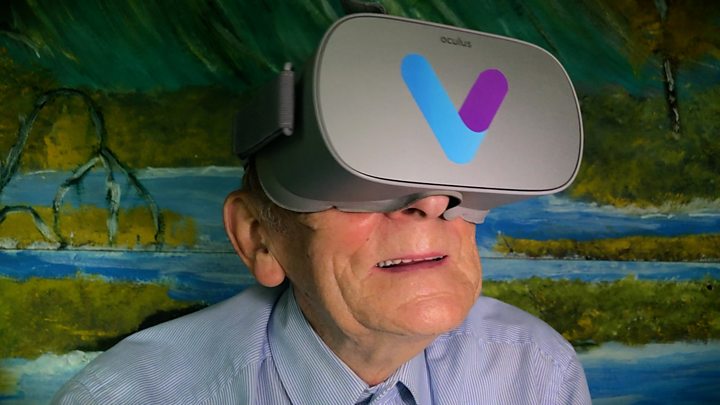Image copyright
Anna Taylor
Anna Taylor with partner Anjay
“When I put in the earpieces and goggles the first time it was crazy – it feels so believable,” says Anna Taylor, 32, of her visit to a virtual reality (VR) arcade.
“The whole experience of being immersed in a compelling virtual world is incredible.”
Anna has since visited the east London arcade many times, at first alone and then with others. But despite her enthusiasm for gaming, she won’t be buying her own virtual reality headset.
“I wouldn’t invest in buying virtual reality applications for home,” she explains. “It’s fine to play more of a basic game when you are playing with other people, [and] because it’s brand new there are more layers of excitement. But when you’re [playing] on your own, you want the quality you are used to.”
As a keen gamer, Anna should be part of the core audience for at-home VR entertainment.
But her lack of interest is pretty common, and it means that virtual reality headsets have yet to take off.
Image copyright
Getty Images
Google has discontinued its VR headset, Daydream
Many big name adopters have abandoned their VR projects. Google recently halted sales of Daydream, its VR headset, admitting that “there just hasn’t been the broad consumer or developer adoption we had hoped”.
Meanwhile, the BBC has announced it is ending the funding for its VR hub, less than two years after it was founded.
And VR received very little attention at CES, the annual trade show for consumer electronics, which got underway this week.
Collective experience
However, one space in which virtual reality is thriving is group entertainment.
By its nature VR offers a gateway to a shared world, and in a group setting everyone gets change from £20 rather than shelling out hundreds for a headset.
East London VR arcade Otherworld launched last year. It already sees 1,000 visitors a week through its doors, 60% of whom are female and half aged 25-34.
“Millennials are spending their income more and more on shared experience over consumption,” says co-founder Chris Adams.
“Otherworld’s immersion rooms provide the space and technology for a hyper-real, undisturbed journey into virtual reality which cannot be achieved at home.”
Simon Windsor, who runs immersive media firm Hammerhead VR, has also largely kept away from the personal entertainment market.
“A few years ago there was an awful lot of hype around VR and some of that has not been fulfilled in terms of consumer adoption of the technology,” Simon admits. “But the way you can interact with this world now is much more natural and intuitive.”
Image copyright
Hammerhead
Madonna and her holographic double at the 2019 Billboard Music Awards
Hammerhead uses VR to create a spectacle for big audiences in the worlds of entertainment, sport and business, alongside company training.
Simon helped create Madonna’s hologram performance at the 2019 Billboard Music Awards and captured Anthony Joshua’s boxing moves for Sky viewers, alongside providing training for companies like Pearson.
“Whether it’s home game play, retail, virtual entertainment, a lot of the technology barriers have been removed,” he says.
Image copyright
Otherworld
Otherworld customers enter pods for a VR experience
Beyond entertainment
Because of its immersive nature, virtual reality is also increasingly used to encourage empathy or create unique experiences.
That could be anything from headsets for children to teach them about bullying, or enabling a care home resident to swim virtually with dolphins or explore their childhood home.

Media playback is unsupported on your device
It has proved particularly useful in medicine, helping surgeons experience different types of operations or distracting burns patients from pain.
Some post-traumatic stress disorder sufferers saw an almost 40% improvement in their symptoms in a trial that involved walking on a treadmill in front of a screen projecting images of the type of trauma experienced.
Mainstream use of virtual reality in our homes and workplaces was probably one of the most popular technology predictions of the past half century.
Unlike flying cars or teleportation, virtual reality headsets have been in development since the late 1960s.
There was a wave of expectation around VR in 2016, seen by many tech watchers as the year virtual reality would go mainstream.
Despite these bursts of optimism, it has never quite broken through. Today, few own their own headsets or use virtual reality in their day-to-day work.
Image copyright
Otherworld
Otherworld virtual reality summer background
Consultancy CCS Insights estimates 10 million headsets will be in circulation worldwide by the end of 2019, 21% growth on the previous year.
But it acknowledges this “might seem disappointing considering the huge hype” around VR, with still just a handful of successful devices available.
A major issue is that the price of headsets has remained very expensive.
“I think VR remains a very niche technology,” says James Gautrey, a portfolio manager at Schroders who specialises in analysing technology stocks.
“Mass adoption remains impeded by the hardware required to run it, in my opinion. Take videogames – you need a very powerful PC, a good amount of space, sensors set up around it, and of course the VR helmet itself.
“The cost runs to thousands and for most it is completely impractical not to mention too expensive.
“There are clearly benefits using it to train people where real life ‘on the job’ training is dangerous, such as pilots, surgeons, deep sea divers. But beyond that and specialist video gamers, I have not seen any compelling use cases that would make it more mainstream.”
